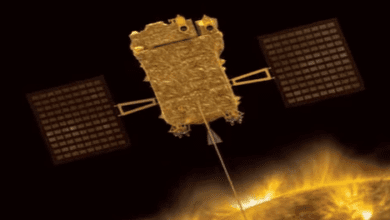India’s First Solar Mission Aditya L1 is Launched from Earth and is Traveling to the Sun-Earth L1 Point
Aditya L1, India’s first solar mission, received a “send-off” from the planet after the fourth and last Earth-bound maneuver was completed in the wee hours of Tuesday.
The spacecraft’s 110-day course to L1, or Lagrange point, a place with equal gravitational pulls from the Earth and the Sun, begins with the Trans-Lagrangian Point 1 Insertion (TL1I) maneuver.
Off to Sun-Earth L1 point!, the Indian Space Research Organization (ISRO) said on the microblogging platform X. Successful completion of the Trans-Lagrangian Point 1 Insertion (TL1I) maneuver. The spacecraft is now traveling toward the Sun-Earth L1 point. It will take around 110 days for a maneuver to place it into an orbit around L1.
According to the space agency, this is the sixth time in a row that it has successfully sent an item on a trajectory to another celestial body or place in space.
Aditya L1, India’s first space-based observatory, will study the sun from a halo orbit around the first Sun-Earth Lagrangian point (L1), which is around 1% of the Earth-Sun distance and is situated at a distance of about 1.5 million kilometers from Earth.
The solar body is a massive sphere of gas, and Aditya-L1 will examine the Sun’s outer atmosphere. The spacecraft won’t approach the Sun any more, and it won’t touch down on its surface either.
Aditya-L1 has been traveling toward L1 point since its launch on September 2 and has completed four Earth-bound maneuvers on September 3, 5, 10, and 15 in that order. During these maneuvers, it gathered the required velocity for its remaining voyage.
Aditya L1 will do another maneuver after it reaches the L1 point to secure the spacecraft in an orbit around L1.
The satellite will spend the whole of its mission circling L1 in an erratic plane that is roughly perpendicular to the line between the Earth and the Sun.
ISRO announced shortly after the launch that the Aditya-L1 will take about 127 days to reach its planned orbit at the L1 point.
On September 2, the Satish Dhawan Space Centre (SDSC) in Sriharikota successfully launched ISRO’s Aditya L1 on Polar Satellite Launch Vehicle (PSLV-C57).
Seven separate payloads are carried by the spacecraft to investigate the Sun; four of them will measure solar light while the other three will monitor plasma and magnetic field properties in situ.
The payloads were created domestically by ISRO and national research organizations including the Inter University Centre for Astronomy and Astrophysics (IUCAA) and Indian Institute of Astrophysics (IIA), both in Bengaluru.
Aditya-L1 flew for 63 minutes and 20 seconds that day before being successfully injected into an elliptical orbit of 23519500 km around the planet.
A significant benefit of having a spacecraft in the halo orbit around the L1 point is that it can see the Sun continuously without experiencing any eclipses. This will allow for real-time observation of the sun’s activities and their impact on the space weather.
The payloads of the spacecraft will conduct observations utilizing detectors of electromagnetic, particle, and magnetic fields.
Four payloads use the unique perspective point L1 to see the Sun directly, while the other three payloads use the Lagrange point L1 to conduct in-situ particle and field research. The instruments on board will provide us access to a wide variety of information, including details on the magnetic field, the Sun’s outer layer, the corona, and its emissions.
The anticipated cost of the Aditya L1 mission is Rs 424 crore, or US$570 million.
A tiny object prefers to remain at one of five Lagrangian points (or parking zones) between the Earth and the Sun, according to experts. The Italian-French mathematician Joseph-Louis Lagrange is the inspiration for the name of the Lagrange Points, which he gave to his prize-winning article “Essai sur le Problème des Trois Corps, 1772.” Spacecraft may utilize these locations in space to stay there for longer periods of time while using less fuel.
The gravitational attraction of the sun and the earth, which are at a Lagrange point, equals the centripetal force needed for a tiny object to move with them.







